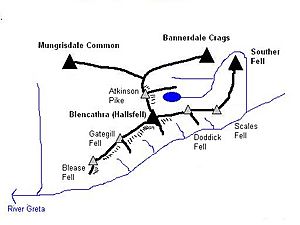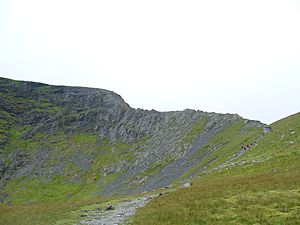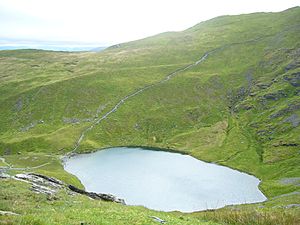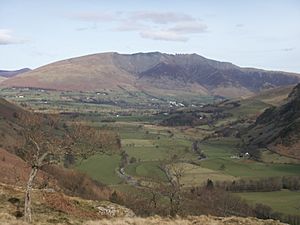Blencathra facts for kids
Quick facts for kids Blencathra |
|
|---|---|
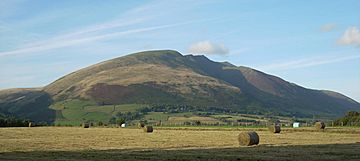
Blencathra from Castlerigg stone circle
|
|
| Highest point | |
| Elevation | 868 m (2,848 ft) |
| Prominence | 461 m (1,512 ft) |
| Parent peak | Skiddaw |
| Listing | Hewitt, Marilyn, Nuttall, Wainwright |
| Geography | |
| Location | Cumbria, England |
| Parent range | Lake District, Northern Fells |
| OS grid | NY323277 |
| Topo map | OS Landranger 90, Explorer, OL4, OL5 |
| Listed summits of Blencathra | ||||
| Name | Grid ref | Height | Status | |
|---|---|---|---|---|
| Gategill Fell Top | NY317273 | 851 m | Nuttall | |
| Atkinson Pike | NY324282 | 845 m | Nuttall | |
Blencathra, also known as Saddleback, is a famous mountain in the Lake District in England. It's one of the most northern hills in the area. Blencathra has six different tops, and the highest one is called Hallsfell Top. This peak reaches 2,848 feet (868 metres) into the sky!
Contents
What's in a Name?
For a long time, maps from the Ordnance Survey called this mountain Saddleback. This name came from how the mountain looks like a horse's saddle when you see it from the east.
But a famous guidebook writer, Alfred Wainwright, helped make the older name, Blencathra, popular again. This name comes from an old language called Cumbric. It likely means "the summit of the seat-like mountain." Today, almost everyone uses the name Blencathra. However, the Ordnance Survey still shows both names on its maps.
How Blencathra Looks
Blencathra isn't just one single mountain. It's more like a small mountain range! It has several tops along a curving ridge that is about 3 miles (5 kilometres) long.
If you look at Blencathra from the north or west, its slopes look smooth and easy to walk on. But from the south and east, it's very different. Here, you'll see lots of rocky ridges and steep, loose slopes.
A Symmetrical View
When you see Blencathra from the southeast, especially from the main road between Keswick and Penrith, it looks almost perfectly balanced. On both sides, the mountain rises smoothly from the lowlands. These ends are called Blease Fell on the west and Scales Fell to the east.
In between these two ends are three more tops: Gategill Fell, Hallsfell, and Doddick Fell. This gives the mountain ridge a wavy or "scalloped" shape.
Spurs and Gills
From each of the three central tops, a rocky ridge, called a spur, sticks out. These spurs start narrow and rocky, then get wider as they drop about 2,000 feet (600 metres) to the base of the mountain.
Between these five tops, there are four streams that flow down the southeast side. From west to east, these streams are Blease Gill, Gate Gill, Doddick Gill, and Scaley Beck.
Hallsfell also has a high ridge that goes north. This is the "saddle" part that gave Blencathra its other name. Beyond this saddle is the sixth top, Atkinson Pike. This area connects to other ridges leading to Bannerdale Crags and Mungrisdale Common in the north.
Sharp Edge: A Thrilling Path
One of the most famous and exciting parts of Blencathra is called Sharp Edge. This is a very narrow, rocky ridge, or arête, that connects Tarn Crag and Foule Crag. It's known for being a challenging climb.
Alfred Wainwright, the famous hiker, said that Sharp Edge is "sharp enough for shaving." He warned that you might have to sit astride it to get across, which could be a bit risky! It's a real adventure for people who are good at scrambling and don't mind heights.
Below Tarn Crags, you'll find Scales Tarn. A tarn is a small mountain lake. Scales Tarn is almost perfectly round and sits in a bowl-shaped hollow called a corrie. The water here is very deep, about 25 feet (7.6 metres), and not many plants or fish live in it.
To the east of Scales Fell, the mountain connects to Souther Fell. This ridge continues northeast towards Mungrisdale.
Mountain Makeup
Blencathra is mostly made of rocks from the Skiddaw Group. These rocks are very old, from a time called the Ordovician period. They are mostly made of layered mudstone and siltstone.
There used to be a lot of mining under Blencathra's slopes. For example, Threlkeld mine was at the base of Hallsfell. From 1879 to 1928, it was a busy mine where people dug for lead and zinc. There are still more metals there, but it's not profitable to mine them right now.
Other smaller mines, like Saddleback Old Mine, also existed. They mostly looked for lead and a mineral called limonite.
The Summit Views
The very top of Blencathra is on the Hallsfell spur. You'll find a concrete ring there, which is a survey marker. A clear path connects the five main summits along the ridge. From here, you get amazing views down the southeast side of the mountain.
On the grassy "saddle" part to the north, there's a large cross made of white stones. No one is quite sure how it started, but it grew to be over 10 feet (3 metres) long thanks to a man named Harold Robinson after World War II.
The views from the summit are incredible! Because the slopes drop sharply from the top, you can see very far in every direction.
- To the west, you'll see the huge Skiddaw mountain.
- Looking from west to northeast, you can see the fells behind Skiddaw. Beyond them, on a clear day, you might spot mountains in Galloway, the Southern Uplands, and the Cheviots.
- The Pennines mountains stretch across the horizon from northeast to southeast. You can see peaks like Cross Fell and Mickle Fell.
- To the south, you'll see the Helvellyn range, and even parts of Forest of Bowland and North Wales.
- The best view is from the south to the west-southwest. Here, you can see a jagged line of all the major Lakeland peaks. These include Coniston Old Man, Scafell Pike (England's highest mountain), Great Gable, and Pillar.
- On very clear days, you can even see the Isle of Man and the Mourne Mountains in County Down, Northern Ireland. The most distant mountain visible is Slieve Meelmore in the Mourne Mountains, which is 123 miles (198 kilometres) away!
The main lakes you can see are Derwent Water and Thirlmere.
Climbing Blencathra
Blencathra is a very popular mountain for hikers, and there are many ways to reach the top.
- Sharp Edge is one of the most famous routes. It's a thrilling, knife-edged ridge that requires some scrambling. This means you'll need to use your hands as well as your feet to climb over rocks. It's best for experienced hikers who are comfortable with heights.
- Hall’s Fell Ridge on the southern side of Blencathra also offers some scrambling. It's not as difficult as Sharp Edge, but it's still an exciting climb. Alfred Wainwright said that climbing from Threlkeld via Hall's Fell ridge is "the finest way to any mountain-top in the district."
Wainwright actually wrote about more ways to climb Blencathra than any other mountain! Some routes, like Blease Fell and Scales Fell, are easier walks on grass. Others, like Gategill Fell, become more interesting as you get closer to the top.
Who Owns Blencathra?
In 2014, the owner of Blencathra, Hugh Lowther, 8th Earl of Lonsdale, decided to sell the entire mountain. He also wanted to sell the title of "Lord of the Manor" of Threlkeld. The price was set at £1.75 million. The Earl needed to sell it to help pay a tax called inheritance tax.
When people heard the mountain was for sale, a group called "Friends of Blencathra" was formed. They started raising money to try and buy the mountain for the community. Famous people like mountaineer Sir Chris Bonington and TV presenter Ben Fogle supported their effort. The National Trust, which owns a lot of land in the Lake District, also supported the Friends of Blencathra.
The local council even listed Blencathra as an "asset of community value." This was the first time a mountain had been given this special status. It gave the community group more time to raise money and talk with the owner.
However, in 2015, the mountain was taken off the market. The Earl found other ways to pay his tax, and there weren't enough serious offers from buyers. The Friends of Blencathra eventually ended their campaign in 2019. The money they had raised, which couldn't be returned to donors, was given to five local charities instead.
|



